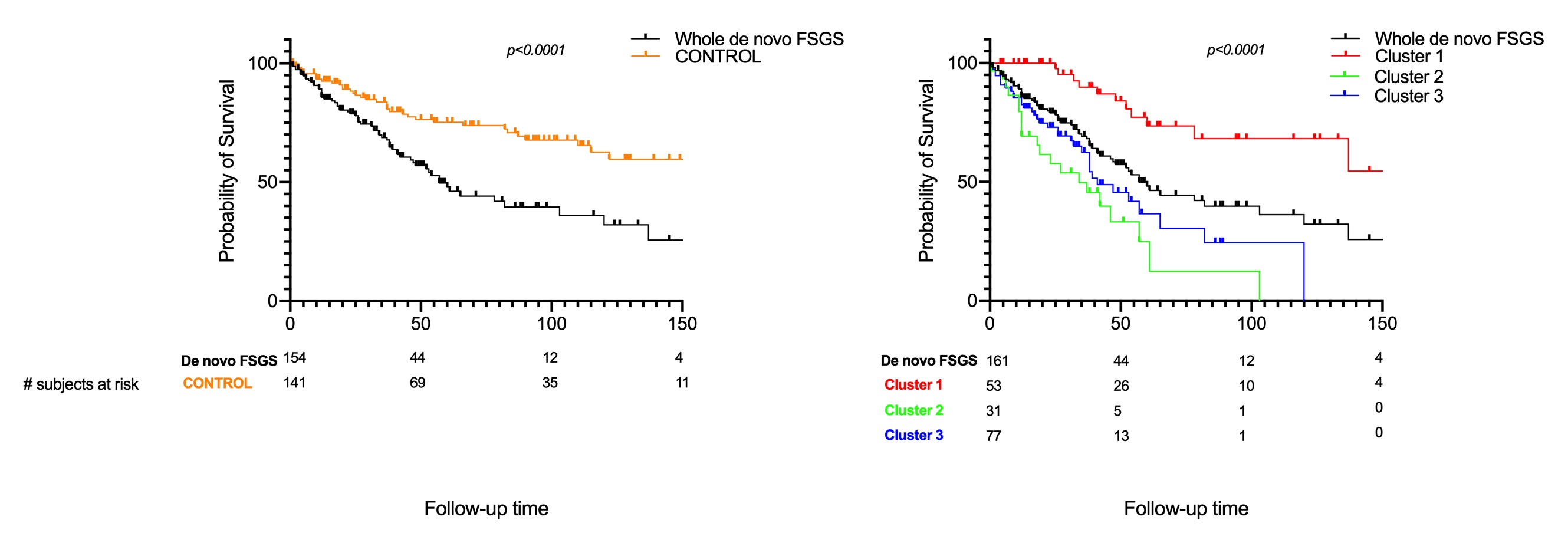De Novo Focal Segmental Glomerulosclerosis in the Kidney Allograft: Association with Alloimmunity Leading to Poor Outcome
1KIDNEY TRANSPLANTATION, Necker Hospital, Paris, France, 2KIDNEY PATHOLOGY, Necker Hospital, Paris, France
Meeting: 2022 American Transplant Congress
Abstract number: 845
Keywords: Fibrosis, Glomerulonephritis, Graft failure, Rejection
Topic: Clinical Science » Kidney » 47 - Kidney Complications: Immune Mediated Late Graft Failure
Session Information
Session Name: Kidney Complications: Immune Mediated Late Graft Failure
Session Type: Poster Abstract
Date: Saturday, June 4, 2022
Session Time: 5:30pm-7:00pm
 Presentation Time: 5:30pm-7:00pm
Presentation Time: 5:30pm-7:00pm
Location: Hynes Halls C & D
*Purpose: Focal Segmental Glomerulosclerosis (FSGS) can be found de novo (Dn) or as a recurrence in kidney allograft. While FSGS recurrence has been extensively described as a devastating cause of graft loss, the natural history, the clinical spectrum and the prognosis of DnFSGS remain unknown.
*Methods: Using a monocentric prospective database, we analyzed retrospectively a cohort of DnFSGS in kidney transplant recipients (KTRs). Pre- and post-transplant characteristics were recorded as well as graft outcomes. The cohort was divided depending on histological characteristics using unsupervised clustering. Propensity score matching was used to compare outcomes in the presence or absence of DnFSGS.
*Results: From 01/2001 to 12/2019, 171 KTRs had a diagnosis of DnFSGS on a biopsy, half of them being at high immunological risk at the time of transplant. The diagnosis was made at an average of 6.3 years post-transplantation, with proteinuria of 1.6 ± 1.6 g/g. In half of the cohort, FSGS lesions occurred after a former diagnosis of rejection. Using a hierarchical clustering on principal components based on histological characteristics, the cohort was split into 3 clusters (K1 to K3). K1 (n=58, 34%) was diagnosed earlier in the post-transplant period, half within the first year, often following the occurrence of an acute antibody-mediated rejection (ABMR). K2 (n=32, 19%) was strongly associated with a concomitant chronic active ABMR whereas K3 (n=81, 47%) was diagnosed later (9.3 ± 6.4 years) in the context of IF/TA and chronic vascular lesions. A total of 67 KTRs (39%) lost their graft over a post-diagnosis follow-up of 3.3 years. Overall, the presence of DnFSGS was associated with poor outcomes in comparison to a control cohort of KTRs post- uropathy or polycystic disease, without lesions (median graft survival of 57 vs 260 months, p=0.001), even after adjusting to the dnFSGS occurrence post-transplant time (adjusted HR 2.01 [1.32-3.11]). K2 presented the worst prognosis (median graft survival 34 months, p= 0.001).
*Conclusions: The occurrence of DnFSGS lesions in KTRs is associated with alloimmunity, in particular ABMR, leading to a poor graft survival.
To cite this abstract in AMA style:
Leon J, Huyen JDuongVan, Abderrahmane A, Anglicheau D, Legendre C, Rabant M. De Novo Focal Segmental Glomerulosclerosis in the Kidney Allograft: Association with Alloimmunity Leading to Poor Outcome [abstract]. Am J Transplant. 2022; 22 (suppl 3). https://atcmeetingabstracts.com/abstract/de-novo-focal-segmental-glomerulosclerosis-in-the-kidney-allograft-association-with-alloimmunity-leading-to-poor-outcome/. Accessed December 28, 2025.« Back to 2022 American Transplant Congress

